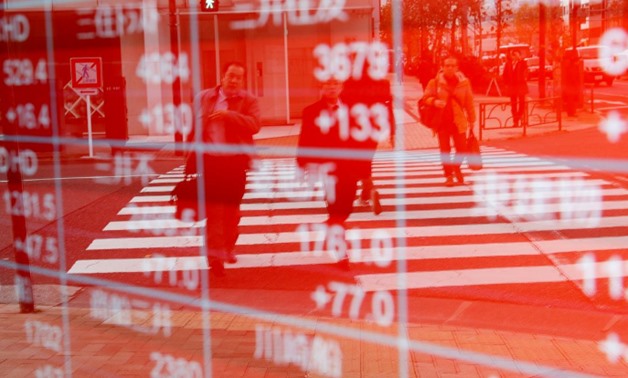
FILE PHOTO: Pedestrians are reflected on an electronic board showing stock prices outside a brokerage in Tokyo, Japan December 27, 2018. REUTERS/Kim Kyung-Hoon
SHANGHAI - 3 January 2019: U.S. stock futures fell and Asian shares stumbled on Thursday after a rare revenue warning from Apple Inc added to worries about slowing global growth and weaker earnings and jolted currency markets.
European markets were expected to follow, with bookmakers predicting London's FTSE .FTSE and Frankfurt's DAX .GDAXI would open 0.4 percent lower and Paris' CAC40 .FCHI down 0.6 percent.
Apple blamed fewer iPhone upgrades and slowing sales in China in its most recent quarter, its first such warning since 2007. Its shares (AAPL.O) tumbled in after-hours trade.
The news sparked a ‘flash crash’ in holiday-thinned currency markets as investors rushed to less risky assets, with the Japanese yen soaring against most major currencies in a matter of seconds.[FRX/]
U.S. stock futures pointed to another rough start on Wall Street, with Nasdaq E-mini futures NQc1 down 2.6 percent and S&P 500 E-mini futures ESc1 off 1.6 percent.
MSCI’s broadest gauge of Asia-Pacific shares outside Japan .MIAPJ0000PUS fell 0.6 percent after an early attempt at a bounce. Japanese markets were closed for holidays but Nikkei futures NKc1 dropped 2.2 percent.
Shares in China .CSI300 and Hong Kong .HSE see-sawed between gains and losses as investors waited for Beijing to roll out fresh support measures for the cooling Chinese economy.
“Chinese authorities have got the luxury of having control not just of the fiscal parts of the government tool case, but also the monetary parts ... and I suspect the Chinese authorities will use that,” said Jim McCafferty, head of equity research, Asia ex-Japan at Nomura.
China’s central bank said late on Wednesday it was adjusting policy to benefit more small firms that are having trouble obtaining financing, in its latest move to ease strains on the private sector, a key job creator.
While more fiscal and monetary policy support had been expected in coming months on top of modest measures last year, some analysts wonder if more forceful stimulus will be needed to stabilise the world’s second-largest economy.
“Despite a more pro-growth policy stance, effectively since mid-2018, we expect growth to continue to slow in the foreseeable future as it appears to us that the government’s policy is still behind the curve,” economists at BofA Merrill Lynch said in a global research report.
“In our view, the next significant stimulus may only occur when the government senses that financial stability is in jeopardy.”
Apple’s surprise announcement weighed on tech shares across Asia, most notably in Taiwan and South Korea. An MSCI index of Korean shares .MIKR00000PUS lost 1.8 percent and Taiwan shares .MITW00000PUS fell 1.4 percent.
Australia bucked the trend, with the ASX 200 bouncing 1.4 percent after the previous day's drubbing. A sudden slide in the Aussie dollar, which fell to near decade lows at one point, boosted shares of miners and other resource exporters despite the weakening China demand outlook. AUD=
The volatile day for Asia followed swings on Wall Street overnight, where shares slid in early trade on growth worries before clawing back losses as surging oil prices drove gains in energy shares. [.N]
Apple specifically highlighted slowing Chinese growth and Sino-U.S. trade tensions, exacerbating investors’ concerns about the health of the global economy.
“The fall in the EM manufacturing PMI last month was fairly broad-based and supports our view that growth in the emerging world as a whole will slow this year,” Gabriella Dickens, an economist at Capital Economics, said in a note.
Adding to the sour mood, a meeting between U.S. President Donald Trump and congressional leaders produced no agreement to end a partial government shutdown.
Trump’s demand for $5 billion in funding for a wall along the U.S.-Mexico border triggered the shutdown affecting about a quarter of the federal government and 800,000 federal workers.
‘FLASH CRASH’
Currency markets saw a wild spike in volatility in early Asian trade, with risk aversion pushing the yen sharply higher against the U.S. dollar, breaking key technical levels and triggering stop-loss sales of U.S. and Australian dollars.
The dollar was last 1.9 percent weaker against the yen JPY= at 106.85, having earlier fallen as low as 104.96, its lowest level since March 2018. The Australian dollar at one point hit levels against the Japanese yen not seen since 2011. AUDJPY=D3
The euro EUR= was up 0.2 percent, buying $1.1365, and the dollar index .DXY, which tracks the U.S. currency against a basket of major rivals, was 0.3 percent weaker at 96.504.
Amid the flight to perceived safety, the yield on benchmark 10-year Treasury notes US10YT=RR was at 2.6328 percent compared with its U.S. close of 2.661 percent on Wednesday.
The two-year yield US2YT=RR, was at 2.4777 percent compared with a U.S. close of 2.504 percent as signs of slowing growth ate away at expectations of further Federal Reserve rate hikes.
U.S. crude CLc1 fell 2.1 percent to $45.57 a barrel, and Brent crude LCOc1 was down 1.2 percent at $54.24. Slowing global growth is expected to coincide with an increase in crude supply, depressing prices.
Gold was higher as the dollar weakened, with spot gold XAU= trading up 0.5 percent at $1,290.91 per ounce.


Comments
Leave a Comment